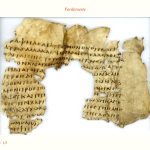| Artefact ID | 1551 |
| TM ID | TM 61841 |
| Findspot (DEChriM ID) | - () | Class | Textual |
| Material | Parchment |
| Writing medium | Codex |
| Text content | Literary |
| Language | Greek |
| Description | P. Schøyen 1 20 (P. Schoyen 1 20), Gregory-Aland 0220, van Haelst 495: "Wyman Fragment" containing Romans 4:23–5:3 [4?]; 5:8–13 |
| Selection criteria | Literary genre (Biblical), Nomina sacra |
| Date from | 250 |
| Date to | 399 |
| Dating criteria | Palaeography. The ed.pr. dates it to the end of the 3rd c. rather than the beginning of the 4th c., Aland 1967 to the 4th c.; Jaros 2005 goes as far back as the 2nd half of the 2nd century. Comfort 2019 places it in the early to middle 3rd c., while stating its “reformed documentary hand” “stands midway between third-century ‘biblical uncials’ and that more fully developed in the fourth century”, like Gregory-Aland 0162 and 0171. He cites a morphological resemblance to Gregory-Aland 0189 and P.Oxy. 4 661. Orsini/Clarysse 2012 reject this early dating and compare the writing on the vellum to P. Oxy. XXXIV 2699 and the Freer Gospel (Codex Washingtonianus). |
| Absolute/relative date | Relative date |
| Archaeological context | Bought in Cairo by Leland C. Wyman on 03.07.1950, claimed to have been found at Fusṭāṭ by the dealer, see ed.pr. Auctioned by an heir in the Wyman family, J. Rocks, via Sotheby’s on 21.06.1988, and purchased by Norwegian collector Martin Schøyen. |
| Accession number | Washington, Museum of the Bible MS.000566; Oslo, Private collection Schøyen MS 113 (previous); Oklahoma, Green collection number unknown (previous) |
ARTEFACT IDENTIFIERS
Reference edition
• Limongi, Donatella. 2005. Papyri Graecae Schøyen (PSchøyen I), edited by Rosario Pintaudi. Papyrologica Florentina XXXV. Firenze: Edizioni Gonnelli. 65-68, No. 20. Plate 14.
• Stevens, Daniel. 2022. “The Wyman Fragment: A New Edition and Analysis with Radiocarbon Dating.” New Testament Studies (NTS) 68(4): 431-444.
Editio princeps
• Hatch, William Henry Paine. 1952. “A Recently Discovered Fragment of the Epistle to the Romans.” Harvard Theological Review (HTR) 45(2). 81-85.
Additional bibliography
• Aland, Kurt and Barbara Aland. 1981/1989. The Text of the New Testament. An Introduction to the Critical Editions and to the Theory and Practice of Modern Textual Criticism, transl. by Erroll F. Rhodes. Grand Rapids, MI: William B. Eerdmans. 60, 104, 125. No. 220.
• Aland, Kurt. 1967. "Das Neue Testament auf Papyrus." In Studien zur Überlieferung des Neuen Testaments und seines Textes. Berlin: De Gruyter. 91-136: 92.
• Aland, Kurt. 1994. Kurzgefasste Liste der Griechischen Handschriften des Neuen Testaments. Zweite, neubearbeitete und ergänzte Auflage. Berlin/New York: De Gruyter. 37, Majuskeln 0220.
• Comfort, Philip Wesley. 2019. The Text of the Earliest New Testament Greek Manuscripts. Papyri 75-139 and Uncials. Volume 2. Grand Rapids, MI: Kregel Academic. 255-256, 356. 0220 (MS 113).
• Jaroš, Karl. 2006. Das Neue Testament nach den ältesten griechischen Handschriften (CD-Rom). Ruhpolding/Mainz: Franz Philipp Rutzen. 4079-4089, no. 2.37.
• Metzger, Bruce M. and Bart D. Ehrmann. 2005. The Text of the New Testament. Its Transmission, Corruption, and Restoration. Fourth Edition. New York/Oxford: Oxford University Press. 86.
• Orsini, Pasquale and Willy Clarysse. 2012. “Early New Testament Manuscripts And Their Dates. A Critique Of Theological Palaeography.” Ephemerides Theologicae Lovanienses 88(4). 443-474: 465-466.
• Turner, Eric G. 1977. The Typology of the Early Codex. Philadelphia: University of Pennsylvania Press. 94, 160. NT parch. 82.
• van Haelst, Joseph. 1976. Catalogue des papyrus littéraires juifs et chrétiens. Paris: Publications de la Sorbonne. 178, No. 495.


 Json data
Json data





